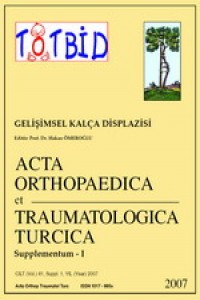Abstract
Bu derlemede gelişimsel kalça displazisinin (GKD) radyolojik tanı ve izleminde son beş yılda ortaya konan kanıta dayalı bazı yeni görüşler özetlenmiştir. Graf yöntemiyle kalça ultrasonografisinde standart plan elde etme oranının 1-6 yaşlar arasında %66 ile %93 arasında değiştiği ve bu oranın özellikle 1-3 yaş arasında %90’ın üzerinde olduğu belirtilmiştir. Gerek Sharp’ın asetabuler açısının gerekse merkez-kenar açısının ölçümlerinde asetabulum tavanının en dış noktası yerine asetabuler subkondral sklerozun en dış noktasının ölçüm noktası olarak kullanılmasının kalça eklemindeki patolojiyi daha doğru tanımlayabileceği bildirilmiştir. Patolojiyi daha etkin biçimde tanımlayabilmek amacıyla, asetabulum ve femur başı merkezleri arasındaki uyumu değerlendirmede MZ uzaklığını ölçmek için iki alternatif yöntem geliştirilmiştir. Bugüne kadar yalnızca bilgisayarlı tomografide ölçülebilen asetabuler anteversiyon için standart ön-arka pelvis grafisinde asetabuler anteversiyon açısı ölçümü tanımlanmıştır. Bu açının düz grafide tanımlanan ön ve arka asetabuler duvar çizgileri arasında ölçüldüğü ve bilgisayarlı tomografi ile elde edilene son derece yakın değerler verdiği ortaya konmuştur. Diğer yöntemde, proksimal femurun değerlendirilmesinde femur başı merkezi ile büyük trokanterin üst ucunun birbirlerine göre konum ve uzaklıklarının milimetre cinsiden ölçüldüğü merkez-trokanter uzaklığı tanımlanmıştır. Gelişimsel kalça displazisi sağaltım sonuçlarının radyografik değerlendirmesinde Severin sınıflamasının yetersiz kalması üzerine, asetabulumun eğimi, proksimal femurun şekli ve asetabulum-proksimal femur ilişkisinin sayısal olarak değerlendirildiği yeni bir radyografik değerlendirme ve skorlama sistemi geliştirilmiştir. Kanıta dayalı bu yeni görüşler klinik uygulamada kullanılabilir nitelikte bulunmuştur.
Keywords
Evidence-based current concepts in the radiological diagnosis and follow-up of developmental dysplasia of the hip
Abstract
This review summarizes some new concepts introduced in the past five years for the radiological diagnosis and follow-up of developmental dysplasia of the hip (DDH). It has been found that the rates of obtaining a standard plain in hip ultrasonography using the Graf method range from 66% to 93% between 1 and 6 years, being greater than 90% between 1 and 3 years. It has been reported that taking the lateral point of acetabular subchondral sclerosis as the measuring point, instead of the lateral point of the acetabular roof, while measuring both the Sharp’s angle and the center-edge angle could better define the global hip pathology. To define the pathology more accurately, two alternative methods have been developed to measure the MZ distance that delineates the congruency between the centers of the acetabulum and the femoral head. Measurement of the acetabular anteversion angle on standard anteroposterior pelvis radiography have been defined, that would otherwise be measured only on computed tomography. This angle is measured between the anterior and posterior acetabular wall lines on a plain radiograph, yielding very close values to those obtained by computed tomography. The other method measures the center-trochanter distance in millimeters between the center of the femoral head and the uppermost point of the greater trochanter to evaluate the proximal femur. As the Severin classification proved to be insufficient for the radiographic evaluation of the treatment results in DDH, a new radiographic classification and scoring system has been developed, that numerically evaluates acetabular inclination, shape of the proximal femur, and the relation between the acetabulum and the proximal femur. These evidence based new concepts are considered useful in the clinical practice.
Details
| Primary Language | English |
|---|---|
| Subjects | Health Care Administration |
| Journal Section | Review |
| Authors | |
| Publication Date | April 18, 2007 |
| Published in Issue | Year 2007 Volume: 41 |

